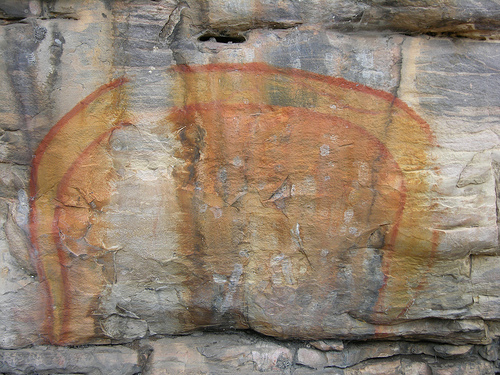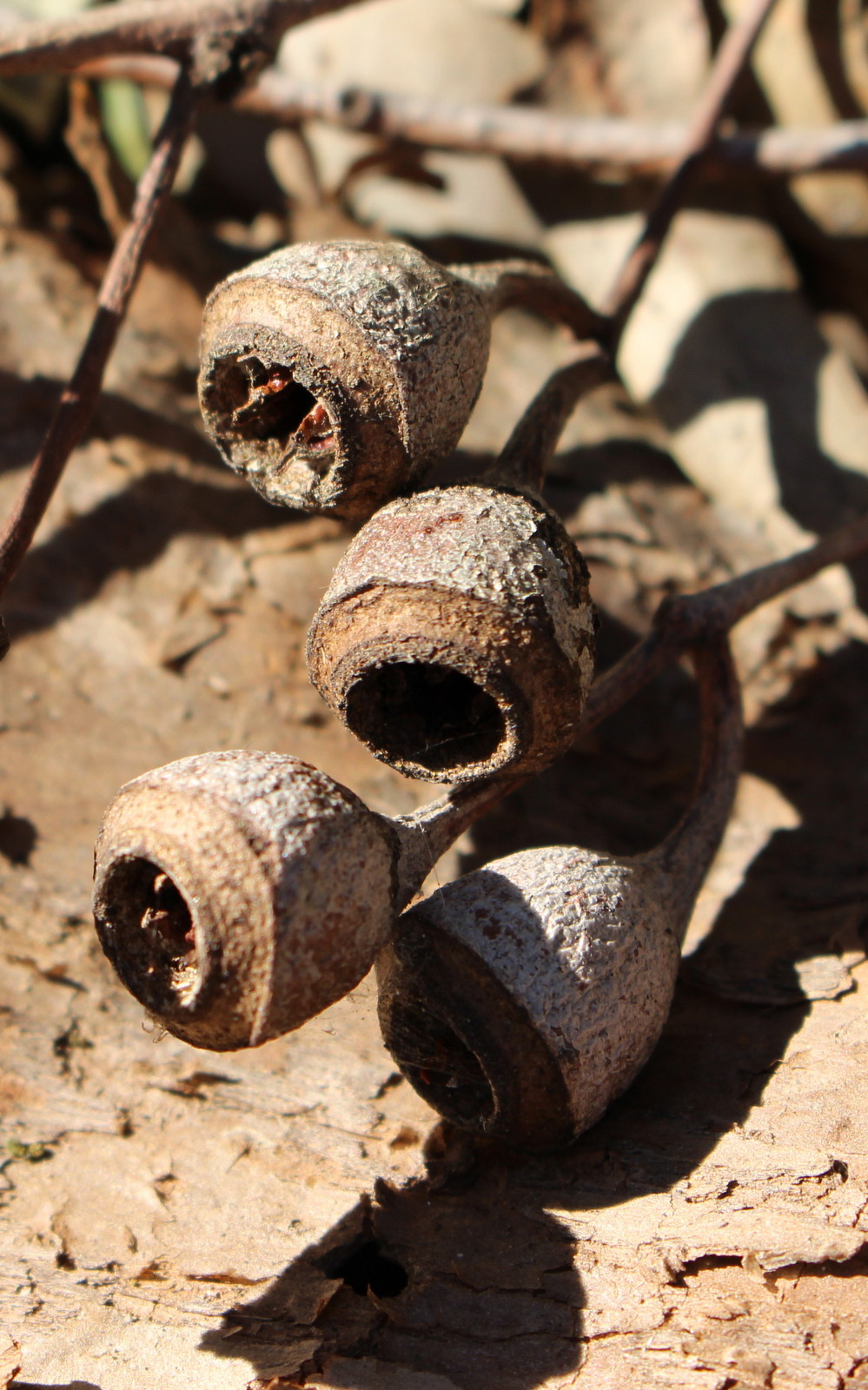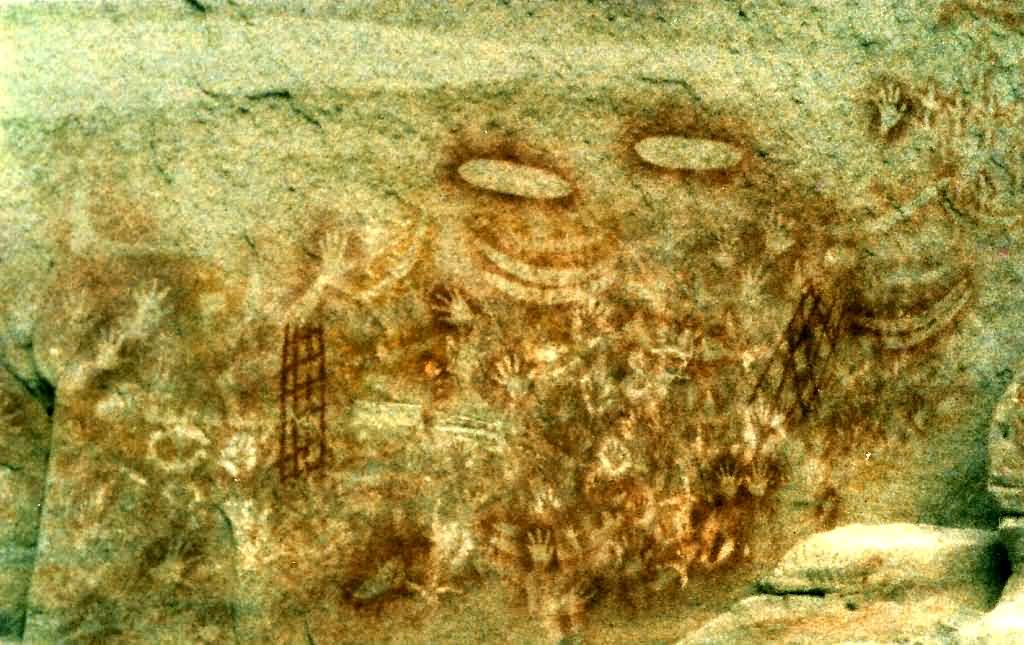|
Dambimangari
The Worrorra, also written Worora, are an Aboriginal Australian people of the Kimberley area of north-western Australia. The term is sometimes used to describe speakers of the (Western) Worrorra language, and sometimes groups whose traditional languages are one of the whole group of Worrorran languages. A native title claim in which the people referred to themselves as the Dambimangari people was lodged in 1998 and determined in 2011. The word is said to be derived from Dambina (a name for the Worrorra) and Ngardi peoples. More recently, it has been spelt Dambeemangarddee. The Worrorra, Wunambal and Ngarinyin peoples make up a cultural bloc known Wanjina Wunggurr, in which the Ngardi are sometimes also included. Country The Worrorra are a coastal people, whose land extends from the area around Collier Bay and Walcott Inlet in the south, northwards along the coastlands of Doubtful Bay west of Montgomery Reef to the area of the Saint George Basin and Hanover Bay, encompas ... [...More Info...] [...Related Items...] OR: [Wikipedia] [Google] [Baidu] |
Wunambal
The Wunambal (Unambal), also known as Wunambal Gaambera, Uunguu (referring to their lands), and other names, are an Aboriginal Australian people of the northern Kimberley region of Western Australia. People The Wunambal were, according to Norman Tindale, "perhaps among the most venturesome of Australian aborigines". They learnt part of the craft of building rafts that could withstand the high rips and tides of the sea, the latter rising as much as , from Makassan visitors to make sailing forays out to reefs (''warar'') and islets in the Cassini and Montalivet archipelagoes, and as far as the northerly Long Reef. The Wunambal bands who excelled in this were the Laiau and the Wardana. The Wunambal, Worrorra, and Ngarinyin peoples form a cultural bloc known as Wanjina Wunggurr. The shared culture is based on the dreamtime mythology and law whose creators are the Wanjina and Wunggurr spirits, ancestors of these peoples. The Wunambal Gaambera Aboriginal Corporation represents the Wu ... [...More Info...] [...Related Items...] OR: [Wikipedia] [Google] [Baidu] |
Ngarinyin
The Ngarinyin or Ngarinjin are an Aboriginal Australian people of the Kimberley region of Western Australia Western Australia (commonly abbreviated as WA) is a state of Australia occupying the western percent of the land area of Australia excluding external territories. It is bounded by the Indian Ocean to the north and west, the Southern Ocean to .... Their language, Ngarinyin language, Ngarinyin, is also known as Ungarinyin. When referring to their traditional lands, they refer to themselves as Wilinggin people. Language Ngarinyin language, Ngarinyin, or Ungarinyin, is one of three languages belonging to the Worrorran languages, Worrorran language family. As of 2003 there were 82 speakers of Ngarinyin spread out from Derby, Western Australia, Derby to the King River (Kimberley, Western Australia), King River. At the time of the 2016 Australian census, there were 38 people recorded to speak the language at home. According to Rumsey, Ngarinyin may be applied to either t ... [...More Info...] [...Related Items...] OR: [Wikipedia] [Google] [Baidu] |
Ngardi
The Ngardi, also spelled Ngarti, are an Aboriginal Australian people of the Northern Territory and Western Australia. Name and grouping Arthur Capell took the term ''Ngardi'' to refer, not to a distinct tribe, but to a branch of the Warlpiri, a point contested by Norman Tindale, who maintained they were distinct. The Wanjina and Wunggurr spirits are essential elements of the life of the cultural bloc known as the Wanjina Wunggurr, generally consisting of the Worrorra, Wunambal and Ngarinyin peoples of the Kimberley. For the purpose of a mineral rights agreement with a mining company in 2006, the Worrorra were also grouped with the Ngardi, as Dambimangari (Dambima-Ngardi), said to share the Wanjina-Wunggurr belief systems. Rock paintings depicting Wanjina, as well as the Gwion Gwion ("Bradshaw") paintings, are evidence of the shared culture. Country In Norman Tindale's calculations, the Ngarti's tribal territory stretched over approximately , covering the sandhill ... [...More Info...] [...Related Items...] OR: [Wikipedia] [Google] [Baidu] |
Wanjina
The Wandjina, also written Wanjina and Wondjina and also known as Gulingi, are cloud and rain spirits from Australian Aboriginal mythology that are depicted prominently in rock art in Australia. Some of the artwork in the Kimberley region of Western Australia dates back to approximately 4,000 years ago. Another closely related spirit entity is the creator being Wunngurr, a being analogous to the Rainbow Serpent in other Aboriginal peoples' belief systems, but with a different interpretation. The stories of the Wandjina and the artwork depicting them remain important to the Mowanjum Community of Aboriginal people, and are one of the basic cultural elements of the Wanjina Wunggurr cultural bloc, which includes four Aboriginal peoples in the Kimberley. Dreamtime legends Some Dreamtime stories say the Wandjina created the landscape and its inhabitants, and continue to have influence over both. When the spirits found the place they would die, they painted their images on cave wal ... [...More Info...] [...Related Items...] OR: [Wikipedia] [Google] [Baidu] |
Rainbow Serpent
The Rainbow Serpent or Rainbow Snake is a common deity often seen as the creator God, known by numerous names in different Australian Aboriginal languages by the many different Aboriginal peoples. It is a common motif in the art and religion of many Aboriginal Australian peoples. Much like the archetypal mother goddess, the Rainbow Serpent creates land and diversity for the Aboriginal people, but when disturbed can bring great chaos. There are many names and stories associated with the serpent, all of which communicate the significance and power of this being within Aboriginal mythology, which includes the worldview commonly referred to as The Dreaming. The serpent is viewed as a giver of life through its association with water, but can be a destructive force if angry. The Rainbow Serpent is one of the most common and well-known Aboriginal stories and is of great importance to Aboriginal society. Not all of the myths in this family describe the ancestral being as a snake ... [...More Info...] [...Related Items...] OR: [Wikipedia] [Google] [Baidu] |
Eucalyptus Longifolia
''Eucalyptus longifolia'', commonly known as woollybutt, is a species of medium-sized tree that is endemic to eastern Australia. It has thick, fibrous bark on the trunk and larger branches, lance-shaped to curved adult leaves, flower buds in groups of three, white flowers and cup-shaped to cylindrical or hemispherical fruit. The drooping flower heads in groups of three are a distinguishing feature. It grows in heavy soils often near water. Description ''Eucalyptus longifolia'' is a tree that typically grows to a height of and forms a lignotuber. It has rough, fibrous to flaky bark on the trunk and branches thicker than about . The trunk diameter is up to . Young plants and coppice regrowth have stems that are more or less square in cross-section and leaves that are egg-shaped to broadly lance-shaped, long and wide. Adult leaves are lance-shaped to curved, the same dull greyish green on both sides, long and wide, on a petiole long. The flower buds are arranged in groups o ... [...More Info...] [...Related Items...] OR: [Wikipedia] [Google] [Baidu] |
Adansonia Gregorii
''Adansonia gregorii'', commonly known as the boab and also known by a number of other names, is a tree in the family Malvaceae, endemic to the northern regions of Western Australia and the Northern Territory of Australia. Names The specific name "gregorii" honours the Australian explorer Augustus Gregory. The common name "boab" is a shortened form of the generic common name "boa", and is the most widely recognised common name It does, however, have a large number of other common names. Similar names include: * baobab — the common name for the genus as a whole, but often used in Australia to refer to the Australian species * Australian baobab * boabab was in common use from the late 1850s (Perhaps the origin of boab) * baob Gadawon is one of the names used by the local Aboriginal Australian groups. Other names include larrgadi or larrgadiy, which is widespread in the Nyulnyulan languages of the Western Kimberley. Other names include: * bottle tree or bottletree * cream ... [...More Info...] [...Related Items...] OR: [Wikipedia] [Google] [Baidu] |
Dreamtime
The Dreaming, also referred to as Dreamtime, is a term devised by early anthropologists to refer to a religio-cultural worldview attributed to Australian Aboriginal beliefs. It was originally used by Francis Gillen, quickly adopted by his colleague Baldwin Spencer and thereafter popularised by A. P. Elkin, who, however, later revised his views. The Dreaming is used to represent Aboriginal concepts of ''Everywhen'', during which the land was inhabited by ancestral figures, often of heroic proportions or with supernatural abilities. These figures were often distinct from gods, as they did not control the material world and were not worshipped but only revered. The concept of the Dreamtime has subsequently become widely adopted beyond its original Australian context and is now part of global popular culture. The term is based on a rendition of the Arandic word ''alcheringa'', used by the Aranda (Arunta, Arrernte) people of Central Australia, although it has been argued that ... [...More Info...] [...Related Items...] OR: [Wikipedia] [Google] [Baidu] |
Gwion Gwion
The Gwion Gwion rock paintings, Gwion figures, Kiro Kiro or Kujon (previously known as the Bradshaw rock paintings, Bradshaw rock art, Bradshaw figures and the Bradshaws) are one of the two major regional traditions of rock art found in the north-west Kimberley region of Western Australia.McNiven, Ian and Russell, Lynette ''Appropriated Pasts: Indigenous Peoples and the Colonial Culture of Archaeology'' Rowman Altamira 2005 p. 147 The identity of the artists and the age of the art are contended within archaeology and amongst Australian rock art researchers. A 2020 study estimates that most of the anthropomorphic figures were created 12,000 years ago, based on analysis of painted-over wasps' nests. These aspects have been debated since the works were seen, and recorded, in 1891 by pastoralist Joseph Bradshaw, after whom they were named until recent decades. As the Kimberley is home to many traditional owners, the rock art is referred to and known by many different names in the l ... [...More Info...] [...Related Items...] OR: [Wikipedia] [Google] [Baidu] |
Stimson's Python
Children's python (''Antaresia childreni'') is a species of nonvenomous snake in the family Pythonidae. The species is named after John George Children. It is a nocturnal species occurring in the northern half of Australia and generally found on the ground, although it often climbs trees. Usually growing to about in length or more depending on the polymorphic variant, it is typically a reddish-brown colour, darker on the upper surface, and with many darker blotches, especially on younger specimens. The Stimson's python variant has much stronger and more variable colors; often being adorned with reddish-brown to chocolate blotches against lighter tan. It feeds mostly on small mammals and birds, and as with other pythons, it constricts its prey before swallowing it whole. It is a popular pet among reptile enthusiasts. Taxonomy and naming ''Antaresia childreni'' is one of four species in the genus ''Antaresia'', a genus in the family Pythonidae. The genus is named after the star A ... [...More Info...] [...Related Items...] OR: [Wikipedia] [Google] [Baidu] |
Monsoon
A monsoon () is traditionally a seasonal reversing wind accompanied by corresponding changes in precipitation but is now used to describe seasonal changes in atmospheric circulation and precipitation associated with annual latitudinal oscillation of the Intertropical Convergence Zone (ITCZ) between its limits to the north and south of the equator. Usually, the term monsoon is used to refer to the rainy phase of a seasonally changing pattern, although technically there is also a dry phase. The term is also sometimes used to describe locally heavy but short-term rains. The major monsoon systems of the world consist of the West African, Asia–Australian, the North American, and South American monsoons. The term was first used in English in British India and neighboring countries to refer to the big seasonal winds blowing from the Bay of Bengal and Arabian Sea in the southwest bringing heavy rainfall to the area. Etymology The etymology of the word monsoon is not w ... [...More Info...] [...Related Items...] OR: [Wikipedia] [Google] [Baidu] |








